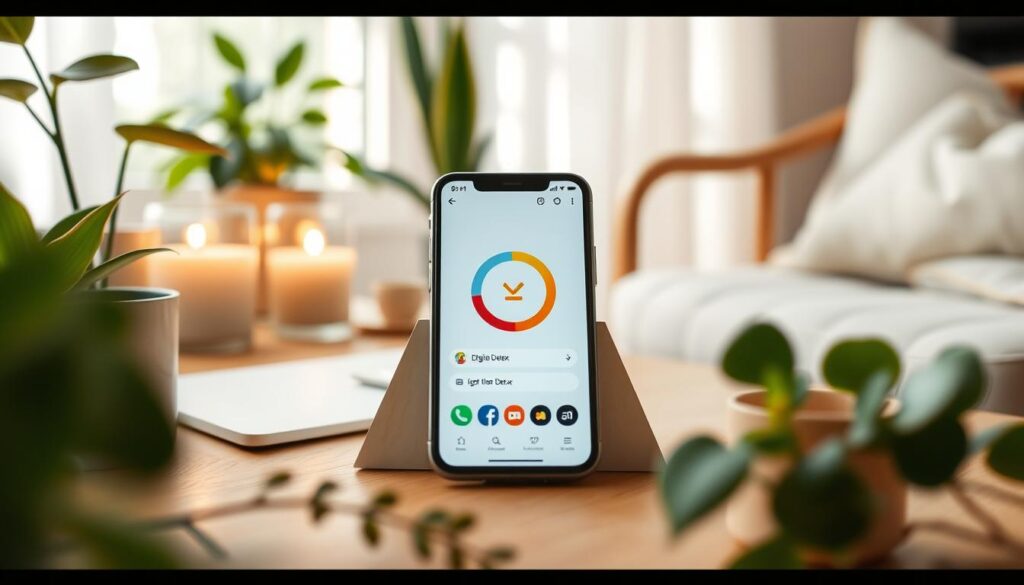How often do you find yourself scrolling through your phone without thinking? Americans spend almost 6.5 hours a day on screens, that’s 42.99% of our waking hours1. This constant use of technology can make us stressed, anxious, and even disrupt our sleep because of blue light12. But there’s a way out. Taking a digital detox can change our lives for the better, bringing balance and peace back.
By managing our screen time, we can clear our minds, work better, and strengthen our relationships. Let’s see how stepping away from screens can refresh our lives.
Key Takeaways
- The average American spends 6.5 hours daily on screens, contributing to feeling overwhelmed1.
- A digital detox can lead to improved focus, productivity, and better sleep quality12.
- Excessive screen time has been linked to increased stress and anxiety levels12.
- Reducing blue light exposure from screens before bedtime can positively impact sleep quality32.
- Reconnecting with real-world relationships can fortify personal bonds and reduce feelings of isolation12.
What is Digital Detox?
A digital detox means taking a break from screens to improve your tech use and well-being4. It helps you focus better, make deeper connections, and take back your time from digital devices.
Definition and Purpose
The main goal of a digital detox is to take breaks from tech. Being always connected can make you less focused and less productive4. It can also cause eye strain and headaches from too much screen time4.
Setting goals, like cutting screen time by two hours a day, helps measure success4. The aim is to use technology more mindfully and live a balanced digital life.
Common Activities to Avoid
During a digital detox, you should avoid certain activities. Social media scrolling can be distracting and make you anxious, affecting 60% of people5. Checking emails and watching too much TV also get in the way.
Steering clear of these habits can improve your mental clarity and sleep. 70% of adults say screens hurt their sleep5. Mindfulness and physical activities help you connect with the world around you46.
Here are some strategies to help you:
- Limit social media to only what’s necessary.
- Make tech-free times, like during meals and before bed5.
- Try offline hobbies and physical activities.
- Set up screen-free zones to promote better habits5.
By knowing what digital detox is and what to avoid, you can improve your tech use. This benefits your mental and physical health456.
The Impact of Excessive Screen Time
Too much screen time affects our health, mental wellbeing, and how we interact with others. This section explores these effects and why managing screen time is crucial.
Physical Health Effects
Long hours in front of screens can harm our bodies. It can lead to insomnia because screens block melatonin release at night7. People who use devices for more than five hours a day are 70% more likely to think about or attempt suicide8.
Being inactive for too long can cause eye strain and pain in the neck, shoulders, and back8.
Mental Health Consequences
Too much screen time also hurts our mental health. Teenagers, since 2010, have seen more depression and anxiety due to screens8. Not talking face-to-face as much makes us feel lonely and isolated8.
Not getting enough sleep because of screens can make us more likely to feel depressed and have mood swings8.
Social Interaction Impairment
Being glued to screens hurts our ability to connect with others in real life. Screen addiction in students has gone down from 20.0% to 14.3% thanks to better management9. But, spending too much time online means we talk less face-to-face, making us feel more alone8.
A big 69.6% of students use screens every day, with 46.3% being very addicted to their phones9. Health officials need to find ways to help us use technology in a healthier way8.
Benefits of a Digital Detox
Going on a digital detox has many benefits for our digital wellbeing. It helps us focus better and think clearer. Studies show that taking a break from screens can make us 40% more productive and 30% clearer in mind after just a weekend10.
This is great for those who feel addicted to technology. It gives them a break from endless notifications and distractions online.
Another big plus is how it improves our real-life social interactions. Not using digital devices helps us make deeper connections and strengthen relationships. A study found that women who stopped using Instagram felt more satisfied with life and were more socially engaged11.
This shows how important it is to balance our online and offline lives. It helps us make better, more meaningful connections.
Reducing screen time also boosts our physical health. Too much screen time can lead to sleep issues, obesity, and higher anxiety and depression11. Blue light from screens can mess up sleep for up to 70% of adults10.
By taking breaks from digital devices, we can sleep better, move more, and feel healthier overall.
Less screen time also helps our mental health. Teens who use screens less often feel happier and less anxious11. Taking breaks from digital devices can lower stress by 37%10.
This shows how important digital detox is for our mental wellbeing.
Lastly, doing physical activities during a digital detox makes us happier. Surveys show that doing so can make us 60% happier10. This highlights the need to unplug and find activities that make us happy and fulfilled.
Creating Your Digital Detox Plan
Creating a digital detox plan means finding the right balance for you. Think about how much and for how long you want to cut down on screens. This will help you smoothly move to a life with less screen time.
Detox Intensity
First, figure out how intense your detox should be. You might choose to use social media less or not use technology at all. Since Australians spend four hours a day on devices, even small changes can make a big difference12.
Setting limits on screen time can also help you feel less anxious and improve your mood13.
Detox Duration
Then, decide how long you want your detox to last. You don’t need to stay off screens forever. Just a few hours a day can be beneficial13.
Making some areas of your home screen-free can help your family talk more and eat together13. Also, cutting down on screen time before bed can help you sleep better13.
Personalizing Your Plan
Make your detox plan fit your life and needs. With almost everyone in the US owning a smartphone, it’s key to know which devices you use the most. Cutting down on these can reduce stress and anxiety, which are linked to mental health problems12.
By focusing on these areas, you can greatly improve your health and life quality.
By thinking about how intense and long your detox should be, and making it personal, you can live a healthier, screen-free life. This will improve your well-being and quality of life.
Tips for Effective Screen Time Management
Managing screen time is key to a healthier digital life. With 97 percent of Americans owning a cell phone, it’s clear screens are a big part of our lives14. Setting goals for digital and device-free living can help. For example, having one digital detox day a week can boost mental health and creativity15.
To cut down on screen time, start by using less each day. The average person spends 7 hours on screens, which can mess with sleep and productivity15. Setting limits, like for kids on social media, is helpful14. Doing things without screens can make us happier by about 25%16.
Try the 20–20–20 rule to avoid eye strain: look at something 20 feet away for 20 seconds every 20 minutes15. Making some areas of your home screen-free, like the kitchen and bedrooms, can improve family time and sleep14. Parents should also plan device-free activities, like reading or playing outside14.
Americans spend about 11 hours a day on digital media, leading to more loneliness16. Limiting social media to 30 minutes a day can give more time for offline activities and personal growth15. These steps help balance digital life and improve overall well-being and happiness.
Only 9% of people set limits on device use, but it can greatly improve life quality16. Parents and individuals can use these strategies to find a better digital balance.
Practical Tips for a Successful Digital Detox
In today’s digital world, keeping our digital lives balanced is key. Here are some tips to help you take a break from tech.
Setting Boundaries
Setting clear limits is vital to fight tech addiction. Studies show that 77% of parents limit their kids’ screen time to promote better habits17. Adults can benefit too, by using tech wisely. Try setting screen time limits and making some areas or times tech-free.
For example, not using screens during meals can cut down screen time by 20%. It also boosts mindfulness and social skills18.
Planning Ahead
Good planning is key for a successful digital detox. Almost 70% of adults suffer from eye strain from screens, which breaks can help prevent17. Also, having screen-free family activities can improve how we talk and connect with each other.
Almost 70% of teens feel rushed to answer social media, showing the need for tech-free times18.
Creating Tech-Free Zones
Designating tech-free areas in your home helps you use tech better. Make rooms like bedrooms or dining areas tech-free to cut down screen time. Using old-school tools like clocks can make you less dependent on phones and more productive, with 75% of users seeing better results18.
These steps are a smart way to improve your digital health and reduce the harm of too much screen time.
Enjoyable Activities Without Screens
Doing things without screens is key for a healthy digital life. Outdoor fun, reading, and family time are great. They let us connect deeply with ourselves and the world around us.
Outdoor Adventures
Getting outside is a great way to avoid screens. Hiking, biking, and walking in nature are good for body and mind. Research shows that outdoor activities like hiking can cut stress by up to 50%19.
Nature offers a calm break and helps avoid eye strain and tiredness19.
Reading
Reading is a top screen-free activity. It sharpens the mind, boosts creativity, and takes us to new worlds. Reading and drawing offline can spark creativity and break screen habits19.
It also helps kids develop a love for books and thinking critically20.
Family Time
Quality time with family is vital for strong bonds. Screen-free meals lead to healthier eating and better family ties20. Face-to-face time creates joy and memories that digital stuff can’t match19.
Sharing activities like games or dinners without screens can improve family ties by 60%19.
Creating screen-free zones at home helps too. These areas encourage kids to play and learn without TV or computer distractions20.
Recommended Apps for Digital Balance
It’s important to balance our digital use for our health in today’s tech world. Digital detox apps help manage screen time and improve digital wellbeing. Here are some top apps for digital balance.
Forest
Forest turns staying off your phone into a game. You plant virtual trees that grow as you stay focused. It also helps real trees grow by supporting reforestation efforts21.
Most people use their phones for over 3 hours a day, making Forest a key tool for less screen time22.
Cold Turkey
Cold Turkey blocks distracting sites and apps, helping you focus. It has different levels for detox challenges. This helps you cut down on screen time and stay accountable23.
It also lets you choose which apps are okay to use during detox, keeping you connected when needed.
One Sec
One Sec makes you pause before checking social media. This pause helps you think before you scroll. RescueTime shows we check our phones 58 times a day, making apps like One Sec very useful22.
Using apps like Forest, Cold Turkey, and One Sec can greatly improve our digital wellbeing. They help us find a healthier balance with our devices.
| App | Key Features | User Benefits |
|---|---|---|
| Forest | Gamification, Environmental Impact | Enhanced Focus, Contribution to Reforestation |
| Cold Turkey | Website and App Blocking, Difficulty Levels, Whitelisting | Improved Task Completion, Built-in Accountability |
| One Sec | Mindful Pause Before Social Media Access | Reduced Impulsive Checking, Increased Mindfulness |
Conclusion
In today’s world, it’s crucial to understand the value of a digital detox and managing screen time. The average American spends over 7 hours a day on screens. This can lead to physical and mental health problems24.
A digital detox helps us step back and enjoy offline activities. It’s a way to counteract the negative effects of too much screen time.
Too much screen time can cause stress, anxiety, and depression. It also messes with our sleep patterns, affecting our body’s natural rhythm25. Studies show that cutting down on screen time before bed can improve sleep quality. This leads to better health overall26.
People who take digital detoxes also see better creative skills. They report a 50% boost in creativity after a weekend without screens25.
Adopting these strategies improves our digital wellbeing. It helps us build stronger personal relationships and boosts productivity. For example, 70% of people feel more connected after reducing screen time25.
This shows how important it is to use screens in a balanced way. It helps us lead a healthier, more fulfilling life.
FAQ
What is a digital detox?
What are the common activities to avoid during a digital detox?
How does excessive screen time impact physical health?
What are the mental health consequences of too much screen time?
How does too much screen time affect social interactions?
What are the benefits of a digital detox?
How do I create an effective digital detox plan?
What tips can help me manage screen time more effectively?
How can I ensure a successful digital detox?
What are some enjoyable activities to do without screens?
Which apps can help achieve digital balance?
Source Links
- https://zionhealthshare.org/blog/unplug-recharge-can-a-digital-detox-help-conquer-screen-time-addiction/ – Unplug, Recharge: Can a Digital Detox Help Conquer Screen Time Addiction
- https://www.corporatewellnessmagazine.com/article/the-art-of-digital-detox-strategies-for-reducing-screen-time-and-boosting-mental-health – The Art of Digital Detox: Strategies for Reducing Screen Time and Boosting Mental Health
- https://thriveworks.com/help-with/self-improvement/digital-detox/ – Digital Detox: How to Unplug and Reconnect
- https://mindfulhealthsolutions.com/digital-detox-how-to-reclaim-control-of-your-screen-time-and-boost-happiness/ – Digital Detox: How To Reclaim Control of Your Screen Time and Boost Happiness
- https://www.dfdrussell.org/digital-detox-managing-screen-time-for-better-mental-health/ – Digital Detox: Managing Screen Time for Better Mental Health – DFD Russell Medical Centers
- https://pmc.ncbi.nlm.nih.gov/articles/PMC11109987/ – A Comprehensive Review on Digital Detox: A Newer Health and Wellness Trend in the Current Era
- https://www.harvardpilgrim.org/hapiguide/how-is-screen-time-impacting-your-employees-lives-and-what-can-you-do-about-it/ – Digital Detox and Work-Life Balance Tips For Your Employees – Harvard Pilgrim Health Care – HaPi Guide
- https://pmc.ncbi.nlm.nih.gov/articles/PMC10852174/ – The hazards of excessive screen time: Impacts on physical health, mental health, and overall well-being
- https://pmc.ncbi.nlm.nih.gov/articles/PMC10006589/ – Effect of digital detox program on electronic screen syndrome among preparatory school students
- https://www.nkch.org/blog/the-power-of-digital-detox – The Power of Digital Detox
- https://simplylocalbillings.com/digital-detox-how-unplugging-benefits-your-health – Digital Detox: How Unplugging Benefits Your Health
- https://toolkit.lifeline.org.au/articles/techniques/how-to-do-a-digital-detox – How to do a digital detox
- https://www.ooma.com/blog/home-phone/digital-detox-reducing-screen-time/?srsltid=AfmBOoqSxY2ZhuRIyqnqBV2lDeA_GwtaVrOKeN6BHuqpwGg5Tx4ufvLs – Unplug to reconnect: how to do a digital detox and reduce screen time at home
- https://www.ooma.com/blog/home-phone/digital-detox-reducing-screen-time/?srsltid=AfmBOoo5zbWJn2PG4NYODwGOcUaLiOup_Y44rg7G57m97Z226LaWNfqd – Unplug to reconnect: how to do a digital detox and reduce screen time at home
- https://medium.com/@sumitvp2007/digital-detox-the-ultimate-guide-to-taking-back-control-of-your-screen-time-3128680889fb – Digital Detox: The Ultimate Guide to Taking Back Control of Your Screen Time
- https://michiganhealthandwellness.com/digital-detox-reducing-screen-time-for-mental-well-being/ – Digital Detox: Reducing Screen Time for Mental Well-being
- https://fitnessista.com/digital-detox-tips-and-how-to-reduce-screen-time/ – Digital detox tips and how to reduce screen time – The Fitnessista
- https://theweek.com/health/digital-detox-tips – Addicted to screens? 4 tips for a digital detox that sticks.
- https://medium.com/@helena-m/17-screen-free-ideas-for-digital-detox-8003b2666c71 – 17 screen-free ideas for digital detox
- https://www.brainbalancecenters.com/blog/ideas-for-a-family-fresh-start-reduce-screen-time – Cut Screen Time Now: 10 Fun Family Activities for a Healthy Tech Detox
- https://www.howtogeek.com/android-apps-help-your-digital-detox-journey/ – These 6 Android Apps Will Help Your Digital Detox Journey
- https://www.digitaldetox.com/blog/5-apps-to-limit-screen-time-get-grounded-with-tech-in-your-life/ – 5 Apps to Limit Screen Time: Get Grounded with Tech in Your Life
- https://play.google.com/store/apps/details?id=com.urbandroid.ddc – Digital Detox: Focus & Live – Apps on Google Play
- https://www.rockbottomhope.org/inspirational-blog/digital-detox-how-reducing-screen-time-can-enhance-your-mental-health – Digital Detox: How Reducing Screen Time Can Enhance Your Mental Health — Rock Bottom Hope
- https://medium.com/@thelitguide/digital-detox-reducing-screen-time-in-2025-c67486329b81 – Digital Detox: Reducing Screen Time in 2025
- https://www.webmd.com/balance/what-is-digital-detox – Digital Detox: What to Know






